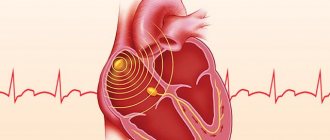Normally, the pulse when walking differs from the indicators at rest by 30-40 beats/min. The final figure on the heart rate monitor depends on the duration and speed of the walk, as well as on the person’s health condition. For example, obese people expend more energy walking, which means their heart rate rises faster. In children, the heart rate when walking (and during rest) is higher than in adults, while closer to adolescence the difference disappears. Of course, for absolutely all athletes, heart rate indicators are directly dependent on the intensity of the workout - the longer and faster you move, the higher the heart rate monitor readings will be.
And yet, there are norms, deviation from which signals health problems. It is important to know them in order to sound the alarm in time. In this article we will tell you what heart rate is considered normal when walking in women, men and children, as well as what to do if your data does not fit within healthy limits. But, before moving on to the numbers, let's find out what this indicator actually affects, why follow it?
The importance of heart rate during training
Monitoring heart rate during training is necessary to:
- determine the intensity of classes;
- effectively use oxygen to generate energy during aerobic exercise;
- choose a load to develop endurance;
- prevent stress on the cardiovascular system.
Those who have problems with the heart and blood vessels should be especially careful during exercise. For such patients, the load is selected based on an ECG machine with tests on a bicycle ergometer.
A sudden achievement of maximum heart rate is also contraindicated for those who have not previously exercised at all. Like other muscles in the human body, the heart needs time to reach a certain exercise regime. The duration of the preparatory period should be from three to six months.
With the correct load, heart rate should be measured several times:
- before classes;
- after warming up;
- at the end of the main part;
- when the load decreases;
- after classes during the cool down process.
IMPORTANT! Pulse is considered a more objective criterion of literacy in classes, in contrast to well-being.
Where is the best place to measure your pulse?
The most convenient place for measuring the pulse is the wrist, on which the radial artery is located. You need to place your index and middle finger on this artery. You cannot apply other fingers, because it is easy to confuse the pulsations of their vessels with contractions of the artery on the wrist.
There are some objective reasons for high heart rate in men, which can distort the correct indicators characteristic of a particular person. So, you cannot measure your pulse:
- for infectious diseases and high body temperature;
- after active sports and other physical activities;
- when taking medications;
- after bath procedures, visiting a sauna and a hot shower;
- during alcohol intoxication;
- after sexual intercourse;
- after prolonged exposure to high or low temperatures;
- on a full stomach.
Pulse zone
Pulse is the rate at which the heart beats over one minute. There is also the concept of a pulse zone, which determines the range from the heart rate at rest to the maximum load on the body.
In everyday life, a person does not need to monitor his pulse zone. But for athletes this parameter is very important. The fact is that when the heart rate is in only one zone, it promotes weight loss; at high values, the endurance of the human body increases
Help: Each person has his own pulse zone, which is determined using laboratory tests.
Nordic walking for weight loss
Recently, Nordic walking has become one of the most popular types of physical activity. Such activities contribute to weight loss no less than regular walking at a fast pace.
With the correct technique, Nordic walking allows you to burn at least 250 kcal in 30-60 minutes, but the speed must be at least 5 km/h. The principle of the “fat-burning pulse zone” also works here, i.e. The heart rate should be 70-80% of the maximum value. To get rid of excess fat, you need to walk for at least 40 minutes at a time.
This type of walking is suitable for people with a weak level of physical fitness, the elderly, and those with certain diseases. Relying on sticks relieves stress on the knee and hip joints and relieves stress on the legs, so it is recommended even for certain health problems. But the decisive factor in this case is the doctor’s opinion.
In general, Nordic walking helps to transition to a healthy lifestyle, strengthen muscles, normalize metabolism, and increase endurance. Since the classes take place outdoors, you can expect improved sleep and mood, as well as overall well-being.
Safe heart rate during exercise
Heart rate is an objective criterion for assessing training load during training. Using heart rate, you can regulate the intensity of your exercise.
During aerobic exercise, heart rate indicators are not informative and cannot be used to regulate strength loads in the gym.
During sports exercises
Physical activity makes the heart beat faster. As a result, the volume of pumped blood is often released into the system to supply the human muscles and organs with oxygen, so the number of shocks increases greatly.
If the body has not previously been exposed to heavy exercise, then a high heart rate during sports is considered normal. For professionals, even during training, the heart rate increases slightly, which is explained by constant cardio loads. The heart muscle gets used to it over time and copes with pumping blood without effort.
Heart rate during strength training
Strength loads are characterized by higher heart rate readings, unlike walking or running. After them, the pulse rises to ninety percent of the maximum, but this value is suitable for healthy people. When there is no preparation or a person has suffered from any illness, the heart rate cannot be increased above 85%. For example, if a person is forty-five years old, then the permissible limit is 85% of the maximum: 220 − 45 = 175, which is 149 beats per minute.
The main thing here is to wait for the pulse to recover before another approach. He should get back to ninety beats per minute. A person should not experience shortness of breath, increased heart rate or discomfort in the heart area. If the pulse has not decreased in seven minutes, then this indicates an incorrectly selected load, and it must be reduced.
Help: If you do strength exercises with a constantly high heart rate, this can disrupt the nutrition of the myocardium.
During cardio training
This category includes fitness training. In other words, your heart rate should be between 135 and 150 beats per minute. But first you need to undergo a special computer examination, which will help determine the upper and lower pulse threshold.
Help: The duration of cardio training should be from forty to fifty minutes.
Heart rate while walking
Walking is extremely beneficial for the human body. They improve well-being, lift your spirits and promote weight loss. The normal heart rate when walking is from 100 to 125 beats per minute. At rest, normal rates are from sixty to one hundred beats per minute.
Heart rate when running in women and men
Normally, the pulse of women and men is different, but besides this indicator, there are others that radically change the final value.
The normal heart rate for men can be determined using averaged data. There are several types of loads, and they all differ in maximum heart rate and training efficiency.
For a man with average physical shape:
- warm-up - from 95 to 115 beats per minute;
- walking - from 115 to 135;
- jogging - from 134 to 154.
Help: Anything higher than the presented indicators is considered excessive and has a negative effect on the human body.
Women's indicators are as follows:
- warm-up - from 97 to 117 beats/min;
- walking - from 117 to 136;
- jogging - from 136 to 155.
While cycling
With such loads, the heart rate becomes seventy percent higher than the maximum. This frequency is used to restore the body after high loads; it can be alternated with an active mode within 70–80 percent.
If classes are held within 75% of the maximum, then endurance increases and fat burning occurs. You can move into the zone with a heart rate of eighty or ninety percent of the maximum and above for no more than one minute.
Heart rate during interval training
These are aerobic exercises that differ from standard ones in that they involve alternating pace and level of stress on the body. This type of training is used by bodybuilders, as interval training helps burn fat without losing muscle mass and increases the volume of the heart, which helps bodybuilders cope with pumping a large volume of blood.
The heart rate during such training ranges from 90 to 100 percent of maximum. Of course, there are programs that assume smaller values. Here everyone chooses the program that suits them best.
Normal for men
The normal heart rate when walking in men is not much different from the indicators for women. However, nature still dictates that a man must spend more energy on life activities than a woman. Kill the mammoth there, protect the family from the dinosaur. Men have larger muscles, a skeleton, and other hormonal processes.
Therefore, at rest, a pulse value of 60-110 beats per minute is acceptable for them, but only on condition that the person leads an active lifestyle. The normal pulse during fast walking in men should not exceed 130 beats/min, while a slight “+/-” to the sides is allowed.
It is important to monitor your general condition during the period of highest stress - is there any shortness of breath, tingling in the heart, or weakness. If you have alarming symptoms, it is better to consult a doctor.
Maximum heart rate in older people
In older people, it is contraindicated to increase the maximum heart rate to ninety percent; seventy percent is enough. These recommendations are suitable for people who do not have heart problems.
But if a person has suffered a heart attack, has angina pectoris or arrhythmia, then it is necessary to select an individual pulse threshold. This can only be done using an ECG with stress. Its meaning is that the patient’s electrocardiogram is recorded at the time of exercise. The doctor uses it to find the maximum limit that the patient should not exceed.
Peculiarities
Tension varies; it depends on the force with which the body is forced to move in the process. By increasing speed, the body increases its need to absorb the substances it needs and changes ongoing physiological processes.
The heart is capable of pumping blood at different speeds. When the stress on the artery walls increases during exercise, the heart rate increases.
If you run, your normal heart rate will be higher than if you sit on the couch, which is logical. This is in a completely healthy and trained person. For people who are overweight, have a fever or other problems, it is even higher. But for such categories, an adjusted plan for working on oneself must be created separately.
If your heart rate is low during exercise
A low heart rate during exercise, as noted above, indicates a disruption in the functioning of the cardiovascular system. Doctors say that people who do not reach one hundred beats per minute in six minutes are at risk of developing a complex form of arrhythmia in the future, so they need to be examined.
A slow pulse is affected by blood pressure lowering medications for tachycardia, lack of thyroid hormones, and stomach ulcers. Professional athletes tend to have low heart rates due to overtraining.
You need to know your pulse during training in order to exercise effectively without harming your heart. For the calculation, the maximum value and zone of permissible increase in aerobic loads are used. The correct training plan is one that slows your resting heart rate.
A little theory
The pulse is the rhythmic movement of the artery walls that occurs due to cardiac activity. This is the most important biomarker of human health, which was first noticed in ancient times.
In simple terms, the heart “pumps blood” by making jerky movements. The entire cardiovascular system, including the arteries through which blood moves, reacts to these shocks. At the same time, heart rate and pulse are not the same thing, since not every heart beat generates a wave that reaches the radial artery. However, the higher this difference, the greater the so-called pulse deficit, inflated values of which indicate the presence of diseases of the cardiovascular system.
Let's see what effect walking has on heart rate:
- During a walk, the blood is saturated with oxygen, the body becomes healthier, and immunity increases;
- The cardiovascular system is strengthened;
- There is a normal load on all muscle groups, in which the body does not work for wear. Therefore, such training is allowed for the elderly, children, pregnant women, and people who are regaining physical shape after serious illnesses or injuries;
- There is an activation of metabolic processes, wastes and toxins are more actively eliminated, and moderate fat burning occurs.
- Walking is an excellent exercise for preventing varicose veins, and is also one of the few approved sports activities for obese people. During such training, they can easily maintain a normal heart rate, which is important for performance.
In 60 minutes of walking at a moderate pace, you will burn at least 100 kcal.
Changes with increased heart rate
When jogging, it is 120-130 beats per minute. This is the most suitable atmosphere, it makes it easier to absorb oxygen from the blood. This has little effect on changes in the body - no weight is lost and no mass is gained. But you won’t be able to get exhausted in the process either.
From the useful:
- Heart training. With the help of such activities, you can improve blood supply to the whole body, stabilize the nervous system, and prevent diseases.
- Memory abilities and reaction speed become better.
- Fat burning level. This running heart rate is the level that is perceived as a signal to use fats instead of carbohydrates for energy. The main rule is to run for at least 20 minutes.
- Health improvement. In addition, stress and anxiety levels decrease.
Higher - from 130 to 145 beats per minute. This is what athletes usually do before going to the main part of the training. This is no longer a health jog, but it’s not yet a training run either. It is advisable to maintain a similar rhythm for at least a couple of minutes, then the body will prepare for more drastic exercises.
What heart rate should be while running - the norm for any future champion varies. A steadily training person has 140 at an increased pace of movement and average speed. Heart rate is a rather individual indicator. Where the beginner is out of breath and unable to continue, the experienced runner is not even tired yet. Age should also be taken into account. If at 55 years old the race causes 140, then at 20 years it is usually no more than 120.
A frequency of up to 165 is considered a training frequency, but this is usually used by athletes who develop endurance. Changes occur in the body that fitness enthusiasts use in the short term to lose fat. You can't run like this for a long time.
When training for acceleration, you need to alternate between the fastest movement at values of 175-180 and slow movement. This beating speed can be harmful if you practice on your own. Acceleration to such body capabilities is allowed only under the supervision of an experienced mentor.
Jogging at the usual level
For professionals and simply physically developed people who regularly engage in such exercises, this is normal.
When the rate exceeds the normal level, the runner temporarily returns to a walk, waits for the heart rate to decrease, then accelerates again. Usually he moves at this rhythm for half an hour.
It is important to observe your own breathing. Each inhalation and exhalation is usually deep and unhurried, the duration of each repeats the previous one. This makes it easier to recover and not stop.
If you try to run, despite your heart jumping out of your chest, then instead of a quality workout you will only get harm.










